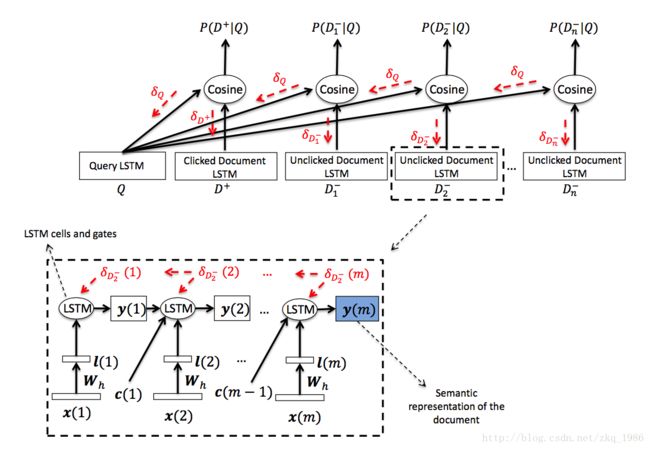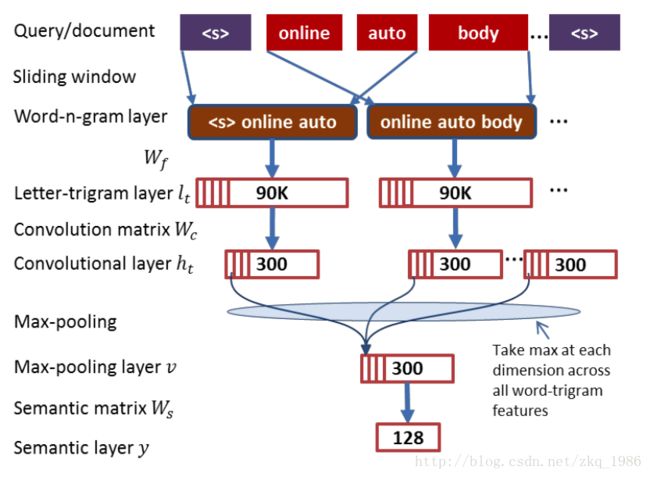【NLP】DSSM深度结构化语义模型原理
DSSM
DSSM的结构
Learning Deep Structured Semantic Models for Web Search using Clickthrough Data以及其后续文章
A Multi-View Deep Learning Approach for Cross Domain User Modeling in Recommendation Systems的实现Demo。
1. 数据
DSSM,对于输入数据是Query对,即Query短句和相应的展示,展示中分点击和未点击,分别为正负样,同时对于点击的先后顺序,也是有不同赋值,具体可参考论文。
对于我的Query数据本人无权开放,还请自行寻找数据。
2. word hashing
原文使用3-grams,对于中文,我使用了uni-gram,因为中文本身字有一定代表意义(也有论文拆笔画),对于每个gram都使用one-hot编码代替,最终可以大大降低短句维度。
3. 结构
结构图:
![]()
- 把条目映射成低维向量。
- 计算查询和文档的cosine相似度。
3.1 输入
这里使用了TensorBoard可视化,所以定义了name_scope:
with tf.name_scope('input'):
query_batch = tf.sparse_placeholder(tf.float32, shape=[None, TRIGRAM_D], name='QueryBatch')
doc_positive_batch = tf.sparse_placeholder(tf.float32, shape=[None, TRIGRAM_D], name='DocBatch')
doc_negative_batch = tf.sparse_placeholder(tf.float32, shape=[None, TRIGRAM_D], name='DocBatch')
on_train = tf.placeholder(tf.bool)- 1
- 2
- 3
- 4
- 5
3.2 全连接层
我使用三层的全连接层,对于每一层全连接层,除了神经元不一样,其他都一样,所以可以写一个函数复用。
def add_layer(inputs, in_size, out_size, activation_function=None):
wlimit = np.sqrt(6.0 / (in_size + out_size))
Weights = tf.Variable(tf.random_uniform([in_size, out_size], -wlimit, wlimit))
biases = tf.Variable(tf.random_uniform([out_size], -wlimit, wlimit))
Wx_plus_b = tf.matmul(inputs, Weights) + biases
if activation_function is None:
outputs = Wx_plus_b
else:
outputs = activation_function(Wx_plus_b)
return outputs- 1
- 2
- 3
- 4
- 5
- 6
- 7
- 8
- 9
- 10
其中,对于权重和Bias,使用了按照论文的特定的初始化方式:
wlimit = np.sqrt(6.0 / (in_size + out_size))
Weights = tf.Variable(tf.random_uniform([in_size, out_size], -wlimit, wlimit))
biases = tf.Variable(tf.random_uniform([out_size], -wlimit, wlimit))- 1
- 2
- 3
Batch Normalization
def batch_normalization(x, phase_train, out_size):
"""
Batch normalization on convolutional maps.
Ref.: http://stackoverflow.com/questions/33949786/how-could-i-use-batch-normalization-in-tensorflow
Args:
x: Tensor, 4D BHWD input maps
out_size: integer, depth of input maps
phase_train: boolean tf.Varialbe, true indicates training phase
scope: string, variable scope
Return:
normed: batch-normalized maps
"""
with tf.variable_scope('bn'):
beta = tf.Variable(tf.constant(0.0, shape=[out_size]),
name='beta', trainable=True)
gamma = tf.Variable(tf.constant(1.0, shape=[out_size]),
name='gamma', trainable=True)
batch_mean, batch_var = tf.nn.moments(x, [0], name='moments')
ema = tf.train.ExponentialMovingAverage(decay=0.5)
def mean_var_with_update():
ema_apply_op = ema.apply([batch_mean, batch_var])
with tf.control_dependencies([ema_apply_op]):
return tf.identity(batch_mean), tf.identity(batch_var)
mean, var = tf.cond(phase_train,
mean_var_with_update,
lambda: (ema.average(batch_mean), ema.average(batch_var)))
normed = tf.nn.batch_normalization(x, mean, var, beta, gamma, 1e-3)
return normed- 1
- 2
- 3
- 4
- 5
- 6
- 7
- 8
- 9
- 10
- 11
- 12
- 13
- 14
- 15
- 16
- 17
- 18
- 19
- 20
- 21
- 22
- 23
- 24
- 25
- 26
- 27
- 28
- 29
- 30
单层
with tf.name_scope('FC1'):
# 激活函数在BN之后,所以此处为None
query_l1 = add_layer(query_batch, TRIGRAM_D, L1_N, activation_function=None)
doc_positive_l1 = add_layer(doc_positive_batch, TRIGRAM_D, L1_N, activation_function=None)
doc_negative_l1 = add_layer(doc_negative_batch, TRIGRAM_D, L1_N, activation_function=None)
with tf.name_scope('BN1'):
query_l1 = batch_normalization(query_l1, on_train, L1_N)
doc_l1 = batch_normalization(tf.concat([doc_positive_l1, doc_negative_l1], axis=0), on_train, L1_N)
doc_positive_l1 = tf.slice(doc_l1, [0, 0], [query_BS, -1])
doc_negative_l1 = tf.slice(doc_l1, [query_BS, 0], [-1, -1])
query_l1_out = tf.nn.relu(query_l1)
doc_positive_l1_out = tf.nn.relu(doc_positive_l1)
doc_negative_l1_out = tf.nn.relu(doc_negative_l1)
······- 1
- 2
- 3
- 4
- 5
- 6
- 7
- 8
- 9
- 10
- 11
- 12
- 13
- 14
- 15
合并负样本
with tf.name_scope('Merge_Negative_Doc'):
# 合并负样本,tile可选择是否扩展负样本。
doc_y = tf.tile(doc_positive_y, [1, 1])
for i in range(NEG):
for j in range(query_BS):
# slice(input_, begin, size)切片API
doc_y = tf.concat([doc_y, tf.slice(doc_negative_y, [j * NEG + i, 0], [1, -1])], 0)- 1
- 2
- 3
- 4
- 5
- 6
- 7
3.3 计算cos相似度
with tf.name_scope('Cosine_Similarity'):
# Cosine similarity
# query_norm = sqrt(sum(each x^2))
query_norm = tf.tile(tf.sqrt(tf.reduce_sum(tf.square(query_y), 1, True)), [NEG + 1, 1])
# doc_norm = sqrt(sum(each x^2))
doc_norm = tf.sqrt(tf.reduce_sum(tf.square(doc_y), 1, True))
prod = tf.reduce_sum(tf.multiply(tf.tile(query_y, [NEG + 1, 1]), doc_y), 1, True)
norm_prod = tf.multiply(query_norm, doc_norm)
# cos_sim_raw = query * doc / (||query|| * ||doc||)
cos_sim_raw = tf.truediv(prod, norm_prod)
# gamma = 20
cos_sim = tf.transpose(tf.reshape(tf.transpose(cos_sim_raw), [NEG + 1, query_BS])) * 20- 1
- 2
- 3
- 4
- 5
- 6
- 7
- 8
- 9
- 10
- 11
- 12
- 13
- 14
3.4 定义损失函数
with tf.name_scope('Loss'):
# Train Loss
# 转化为softmax概率矩阵。
prob = tf.nn.softmax(cos_sim)
# 只取第一列,即正样本列概率。
hit_prob = tf.slice(prob, [0, 0], [-1, 1])
loss = -tf.reduce_sum(tf.log(hit_prob))
tf.summary.scalar('loss', loss)- 1
- 2
- 3
- 4
- 5
- 6
- 7
- 8
3.5选择优化方法
with tf.name_scope('Training'):
# Optimizer
train_step = tf.train.AdamOptimizer(FLAGS.learning_rate).minimize(loss)- 1
- 2
- 3
## 3.6 开始训练
# 创建一个Saver对象,选择性保存变量或者模型。
saver = tf.train.Saver()
# with tf.Session(config=config) as sess:
with tf.Session() as sess:
sess.run(tf.global_variables_initializer())
train_writer = tf.summary.FileWriter(FLAGS.summaries_dir + '/train', sess.graph)
start = time.time()
for step in range(FLAGS.max_steps):
batch_id = step % FLAGS.epoch_steps
sess.run(train_step, feed_dict=feed_dict(True, True, batch_id % FLAGS.pack_size, 0.5))- 1
- 2
- 3
- 4
- 5
- 6
- 7
- 8
- 9
- 10
GitHub完整代码 https://github.com/InsaneLife/dssm
Multi-view DSSM实现同理,可以参考GitHub:multi_view_dssm_v3
CSDN原文:http://blog.csdn.net/shine19930820/article/details/79042567
上面是 DSSM 训练的架构图:
- 输入的是一个
query和这个query相关的doc,这里的输入特征可以是最简单的one-hot,而需要train的是这个query下各个doc的相关性(DSSM里面使用点击率来代替相关性) -
由于这种
one-hot的输入可能会有两个问题:- 导致
vocabulary太大 -
会出现
oov的问题因此输入特征之后的第一层是做一个叫做
Word Hashinging的操作
- 导致
- 接下来就是传统的神经网络了
$$l_i=f(W_il_{i-1}+b_i),i = 2,…,N-1 \\
y=f(W_Nl_{N-1}+b_N) $$这里的
f是激活函数,文中使用$tanh$来计算:$f(x)=\frac{1-e^{-2x}}{1+e^{-2x}}$ - 得到的$y$就是语义特征了,query和doc之间的相关性就可以直接使用特想之间的相似性来度量,这里使用cosine来计算
$$R(Q,D)=cosine(y_Q,y_D) = \frac{y_Q^Ty_D}{||y_Q||||y_D||}$$ - 最终得到的相似度就可以去训练query和doc的相关性了
因此整个结构就可以看做做了一层 Word Hashing 之后去训练 DNN 网络
Word Hashing
Word Hashing 是paper非常重要的一个 trick ,以英文单词来说,比如 good ,他可以写成 #good# ,然后按tri-grams来进行分解为 #go goo ood od# ,再将这个tri-grams灌入到 bag-of-word 中,这种方式可以非常有效的解决 vocabulary 太大的问题(因为在真实的web search中vocabulary就是异常的大),另外也不会出现 oov 问题,因此英文单词才26个,3个字母的组合都是有限的,很容易枚举光。
那么问题就来了,这样两个不同的单词会不会产出相同的tri-grams,paper里面做了统计,说了这个冲突的概率非常的低,500K个word可以降到30k维,冲突的概率为0.0044%
但是在中文场景下,这个
Word Hashing估计没有这么有效了
因为直接使用了word hashing,因为无法记录上下文信息
训练DSSM
上面是前向计算过程,在进行训练的时候需要计算给定 Query 下与 Doc 的相关性:
$$P(D|Q) = \frac{exp(\gamma R(Q,D))}{\sum_{d_i \in D} exp(\gamma R(Q,D))}$$
最终他需要优化的损失函数为:
$$L(\Lambda) = - \text{log} \prod_{(Q,D^+)} P(D^+|Q)$$
$D^+$表示被点击的文档,这里就是最大化点击文档的相关性的最大似然
CDSSM
CDSSM (又称 CLSM :Convolutional latent semantic model)在一定程度上他可以弥补 DSSM 会丢失上下文的问题,他的结构也很简单,主要是将DNN 替换成了 CNN
他的前向步骤主要计算如下:
1. 使用指定滑窗大小对输入序列取窗口数据(称为word-n-gram
)
2. 对于这些
word-n-gram
按
letter-trigram
进行转换构成representation vector(其实就是
Word Hashing
)
3. 对窗口数据进行一次卷积层的处理(窗口里面含有部分上下文)
4. 使用
max-pooling
层来取那些比较重要的
word-n-gram
5. 再过一次FC层计算语义向量
6. 他最终输出的还是128维
> 因为使用
CDSSM
来做语义匹配的工作也是比较合适的
## DSSM-LSTM
既然是为了记录输入句子的上下文,这个无疑是
Lstm
这个模型更为擅长,因此又有了一种
Lstm
来构造的
DSSM
模型

这篇相对于 CDSMM 来说改的更为简单,其实就是将原始 DSSM 的模型替换为了 LSTM 模型…
MV-DSSM
MV-DSSM 里面的 MV 为 Multi-View ,一般可以理解为多视角的 DSSM ,在原始的DSSM中需要训练的有 Query 和 Doc 这两类的embedding,同时里面 DNN 的所有权重都是共享的,而 MV-DSSM 他可以训练不止两类的训练数据,同时里面的深度模型的参数是相互独立:

基于
Multi-View
的
DSSM
是的参数变多了,由于多视角的训练,输入的语料也可以变得不同,自由度也更大了,但是随之带来的问题就是训练会变得越来越困难^_^
总结
DSSM 类的模型其实在计算相似度的时候最后一步除了使用Cosine,可能再接入一个MLP会更加好,因为Cosine是完全无参的。
DSSM 的优势:
DSSM看起来在真实检索场景下可行性很高,一方面是直接使用了用户天然的点击数据,出来的结果可行度很高,另一方面文中的doc可以使用title来表示,同时这个部分都是可以离线进行语义向量计算的,然后最终query和doc的语义相似性也是相当诱人DSSM出的结果不仅可以直接排序,还可以拿中间见过做文章:semantic feature可以天然的作为word embedding嘛
DSSM 的劣势:
- 用户信息较难加入(不过可以基于
MVDSSM改造) - 貌似训练时间很长啊
参考
- Huang P S, He X, Gao J, et al. Learning deep structured semantic models for web search using clickthrough data[C]// ACM International Conference on Conference on Information & Knowledge Management. ACM, 2013:2333-2338.
- Shen, Yelong, et al. “A latent semantic model with convolutional-pooling structure for information retrieval.” Proceedings of the 23rd ACM International Conference on Conference on Information and Knowledge Management. ACM, 2014.
- Palangi, Hamid, et al. “Semantic modelling with long-short-term memory for information retrieval.” arXiv preprint arXiv:1412.6629 (2014).
- Elkahky, Ali Mamdouh, Yang Song, and Xiaodong He. “A multi-view deep learning approach for cross domain user modeling in recommendation systems.” Proceedings of the 24th International Conference on World Wide Web. International World Wide Web Conferences Steering Committee, 2015.
